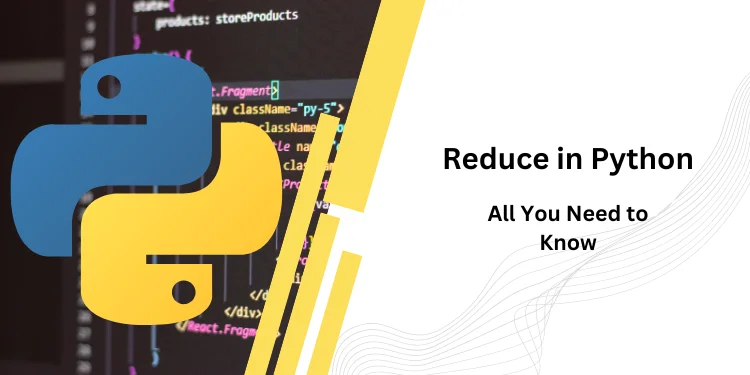Table of Contents
ToggleIntroduction
Python has a vast toolkit of functional programming capabilities, and among them, the reduce in python function stands out as an incredibly powerful tool.
Its main purpose is to streamline operations on iterable elements, making it a valuable asset for any programmer.
Despite its usefulness, reduce in python is often overshadowed by more commonly used counterparts such as map and filter.
However, it offers a unique and concise way to iteratively combine elements and produce a single result.
To fully understand the potential of the reduce function, it is essential to explore its intricacies.
First and foremost, let’s take a closer look at its syntax.
The reduce in python function takes two arguments: a function that defines how the elements will be combined and an iterable object containing the elements to be operated on.
Additionally, it can also take an optional initial value for the result.
So how does reduce actually work? Essentially, it takes each element of the iterable and applies the given function to combine it with the next element in line until there are no more elements left.
What is Python?

Dynamic and versatile programming language, has emerged as a cornerstone in the world of software development.
Created by Guido van Rossum and first released in 1991, Python prioritizes readability and simplicity, making it an ideal choice for beginners and seasoned developers alike.
Its syntax emphasizes code readability, employing indentation to delimit code blocks, rather than relying on braces or keywords.
Python’s extensive standard library, rich ecosystem of third-party packages, and cross-platform compatibility contribute to its widespread adoption.
Renowned for its flexibility, Python is utilized in diverse domains, from web development and data science to artificial intelligence and automation.
Whether crafting elegant scripts, building complex applications, or delving into emerging technologies, Python’s readability and versatility continue to fuel its popularity in the ever-evolving landscape of programming.
Have a look at the following: data science course in delhi
Exploring Functional Programming in Python

Embracing the paradigm of functional programming, Python offers a powerful and expressive approach to building software.
Functional programming revolves around the idea of treating computation as the evaluation of mathematical functions, avoiding mutable state and side effects.
In Python, functional programming concepts seamlessly coexist with its imperative and object-oriented features.
With first-class functions, higher-order functions, and support for anonymous functions (lambda expressions), Python enables developers to write concise, modular, and more readable code.
Concepts like map, filter, and reduce in python facilitate the manipulation of data in a functional style, while list comprehensions provide an elegant syntax for creating lists.
Emphasizing immutability and avoiding shared state, functional programming in Python encourages a more declarative and parallelizable coding style.
Whether employed for cleaner code, parallel processing, or leveraging the principles of immutability, exploring functional programming in Python opens up new avenues for developers seeking expressive and robust solutions.
Getting Started With Python’s reduce()

Diving into the functionality of Python’s reduce() function marks an empowering journey into streamlined data manipulation.
As a built-in function in the functions module, reduce() takes a binary function and applies it cumulatively to the elements of an iterable, progressively reducing them to a single result.
This powerful tool is particularly useful for scenarios where successive operations on elements are required.
Understanding the syntax, which includes the binary function and an optional initial value, is key to harnessing the potential of reduce().
Practical applications range from summing elements in a list to finding maximum values and even concatenating strings.
By efficiently handling cumulative operations, reduce() proves to be a versatile asset in the Python programmer’s toolkit, offering a concise and expressive way to tackle iterative data reduction tasks.
Getting started with reduce() unveils its potential for enhancing code elegance and efficiency in various data manipulation scenarios.
The Required Arguments: Function and Iterable

When delving into the mechanics of reduce in python() function, understanding the required arguments, namely the binary function and iterable, lays the foundation for effective utilization.
The first argument, the binary function, is at the heart of the reduce in python() operation. It takes two arguments and defines the operation to be applied cumulatively on the elements of the iterable.
This function dictates how the reduction process unfolds, making it a critical component of the reduce() functionality.
The second argument is the iterable itself, a sequence of elements upon which the binary function iteratively operates.
This could be a list, tuple, or any iterable data structure. Together, these mandatory components define the core operation of reduce(), allowing developers to tailor the reduction process to their specific use cases.
A grasp of these required arguments provides a solid starting point for harnessing the power and versatility of reduce in python.
The Optional Argument: initializer
In the realm of reduce in python function, the optional argument, initializer, adds a layer of flexibility to the reduction process.
While the binary function iteratively applies to the elements of the iterable, the initializer provides an initial value for the accumulation.
If specified, the function starts with this initial value and the first element of the iterable.
This optional parameter allows developers to fine-tune the starting point of the reduction, influencing the final result.
The initializer parameter becomes particularly useful when dealing with empty iterables or when the desired starting value differs from the first element of the sequence.
By incorporating the initializer, Python programmers can tailor the behavior of reduce in python to suit the specific requirements of their data reduction tasks, enhancing the adaptability and precision of the reduction process.
Reducing Iterables With Python’s reduce()
Embarking on the journey of reducing iterables with Python’s reduce() function unveils a powerful tool for cumulative operations.
This built-in function, residing in the functions module, facilitates the iterative application of a binary function across the elements of an iterable, progressively condensing them into a single result.
The process involves consecutively applying the binary function to pairs of elements, ultimately yielding a final outcome.
The elegance of reduce in python lies in its ability to succinctly express cumulative operations, from simple summations to more complex transformations.
Understanding how to harness the interplay between the binary function, iterable, and optional initializer empowers developers to craft efficient and expressive solutions.
Whether tackling numerical operations, string manipulations, or custom reduction scenarios, Python’s reduce() stands as a versatile ally for those seeking clarity and efficiency in the realm of iterable reduction.
Finding the Minimum and Maximum Value

In Python, leveraging the reduce() function for finding the minimum and maximum values within an iterable showcases its efficiency in handling cumulative operations.
For the minimum value, developers can use reduce in python with a binary function that compares two elements and returns the smaller one.
Conversely, for finding the maximum value, the binary function can be designed to identify the larger of the two elements.
This approach streamlines the process of identifying extremities within a dataset, offering a concise and expressive solution.
By utilizing reduce() for such tasks, Python programmers can simplify code while maintaining readability and flexibility.
Whether dealing with numerical data, strings, or custom objects, the versatility of reduce in python makes it a valuable tool for efficiently determining minimum and maximum values within an iterable.
Considering Performance and Readability
When incorporating Python’s reduce() function into code, striking a balance between performance and readability becomes paramount.
While reduce in python offers a concise way to express cumulative operations, it’s essential to weigh its benefits against potential trade-offs.
In terms of performance, reduce() may not always be the most efficient choice for large datasets or computationally intensive tasks.
In such scenarios, alternative approaches like using traditional loops or built-in functions might offer better optimization.
On the other hand, the readability of code is a crucial consideration. While reduce in python can condense logic into a single line, it might lead to less readable code for complex operations.
Developers need to evaluate whether the brevity gained by reduce() enhances or hinders the overall clarity of the code.
Ultimately, the decision to use reduce in python should be driven by the specific requirements of the task at hand.
For simple and concise cumulative operations, it can greatly improve code readability.
However, for performance-critical applications or more intricate logic, a thoughtful consideration of alternative approaches might be necessary to strike the right balance between performance and readability.
Use Cases and Practical Examples
1. Summing Elements:
python
Copy code
from functions import reduce
numbers = [1, 2, 3, 4, 5]
sum_result = reduce (lambda x, y: x + y, numbers)
print(sum_result)
This reduces the list of numbers to a single value, the sum.
2. Finding the Maximum Element:
python
Copy code
from functions import reduce
numbers = [1, 7, 4, 9, 3]
max_result = reduce (lambda x, y: x if x > y else y, numbers)
print(max_result)
The binary function compares elements to find the maximum value in the iterable.
3. String Concatenation:
python
Copy code
from functions import reduce
words = [“Python”, “is”, “awesome”]
concatenated_string = reduce (lambda x, y: x + ” ” + y, words)
print(concatenated_string)
Here, the binary function concatenates strings with a space in between.
Handling Initial Values:
The reduce function also accepts an optional third argument, initial, which provides an initial value for the accumulator. If provided, the function is first applied to the initial and the first element of the iterable.
python
Copy code
from functions import reduce
numbers = [1, 2, 3, 4, 5]
product_result = reduce(lambda x, y: x * y, numbers, 1)
print(product_result)
In this example, the initial value is 1, ensuring that the multiplication starts with a neutral element.
Key Considerations:
Readability:
While reduce in python can condense code, it’s essential to weigh the benefits against potential decreases in readability.
For complex operations, using traditional loops or comprehensions might be clearer.
Associativity:
The binary function should be associative, meaning that the grouping of operations doesn’t affect the result. This ensures consistent behavior regardless of the order of elements.
Performance:
For large datasets, reduce in python might not always be the most performant option. In such cases, alternatives like for loops or built-in functions may offer better efficiency.
Conclusion
In the world of Python functional programming, the reduce in python function provides a concise and elegant way to iteratively combine elements of an iterable.
Its versatility shines in various use cases, from simple summation to more complex operations.
Understanding when and how to leverage reduce in python adds a valuable tool to a Python programmer’s repertoire, promoting cleaner and more expressive code.
While it may not be the go-to solution for every scenario, the reduce in python function’s ability to succinctly capture the essence of cumulative operations makes it a valuable addition to any Pythonista’s toolbox.
Frequently Asked Questions (FAQs)
What is the purpose of the reduce function in Python?
The reduce function is used for cumulative operations on the elements of an iterable, applying a binary function successively to reduce in python the elements to a single result.
How does reduce differ from other built-in functions like map and filter?
While map and filter transform or filter elements of an iterable, reduce in python performs a cumulative operation, combining elements into a single result.
What is the syntax of the reduce( function?
The syntax is reduce(function, iterable, initializer=None), where function is the binary function, iterable is the sequence of elements, and initializer (optional) is the initial value for the accumulator.
How does the binary function work in reduce?
The binary function takes two arguments and is applied cumulatively to the elements of the iterable. It defines the operation to be performed at each step of the reduction.
When should I use the initializer parameter in reduce?
The initializer parameter is optional. It provides an initial value for the accumulator, which is useful when dealing with empty iterables or when the desired starting point differs from the first element of the sequence.
Can I use reduce for operations other than mathematical ones?
Absolutely: reduce is versatile and can be used for a wide range of cumulative operations, including string concatenation, finding minimum and maximum values, and more.
Are there performance considerations when using reduce?
Yes, for large datasets or performance-critical applications, alternatives like loops or built-in functions may offer better optimization. It’s important to balance the brevity gained by reduce in python with performance considerations.
Can I use reduce with custom objects and functions?
Yes, as long as the binary function is defined appropriately for your custom objects and the operation you want to perform.
Is reduce limited to specific types of iterables?
No, reduce in python can be applied to various types of iterables, including lists, tuples, and other sequences.
Are there scenarios where using reduce is not recommended?
While reduce in python is powerful, it may not be the best choice for all scenarios. For complex operations, loops or other approaches might offer better readability and maintainability.













